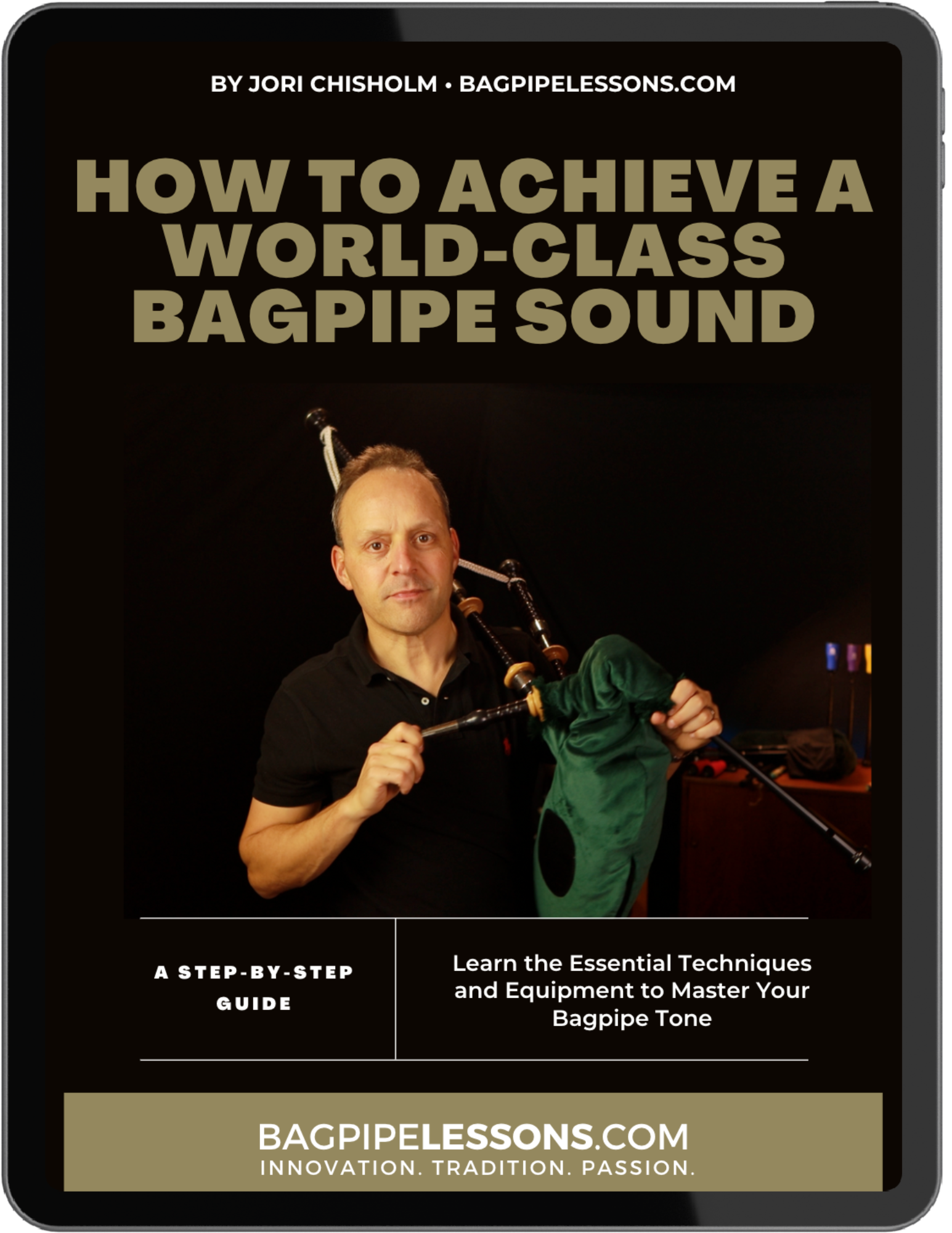
AS FEATURED IN

The Piper’s Ultimate Reed Poker
by Jori Chisholm, Founder of BagpipeLessons.com
Last Updated: April 11, 2025
One of the best-kept secrets of top pipers is the the specialized tool called a reed poker. Use the poker when your pipe chanter reed starts to get a little bit too easy, chirps, squeals, or starts to sound sharp and thin.
As you play a new reed, it starts to break in, getting easier and more efficient. But the cane can get too soft — this is where the reed poker comes in.
A small adjustment (we’re talking 1/1000ths of an inch) to the metal staple inside the reed can bring a reed back to life, extend the playable life of the reed, and give you a brighter, crisper, stronger, more stable sound.
The only way to open up a reed from the inside is with a reed poker. It has a smooth point which allows you to precisely control just how much you want to open the reed. Easy-to-use. Totally intuitive. Simply insert the poker a bit further to open up the reed a little bit more. Other blunt, square-shaped pokers can get stuck or can damage the reed by twisting. The Piper’s Ultimate Reed Poker is a must-have if you want to have a world-class bagpipe sound.
It will bring your reeds back to life and it will save you hundreds of dollars that you’d otherwise spend on new reeds.
Watch the video and scroll down to read the full video script.
Video Transcript: I want to tell you about my new product. I’m really excited about it. It’s called the Piper’s Ultimate Reed Poker. The reed poker is one of the best kept secrets of top pipers and it’s a tool that you can use to save your reed when the reed gets too easy.
When you play a reed and you break it in, the can gets softer and the reed gets easier and more efficient but the can can get too soft and the reed can get too easy and it can lose stability and it can start to chirp or squeal.
So that’s where the reed poker comes in. It allows you to open up the reed from the inside, extend the life of the reed, and bring back that bright solid tone that we like. So your pipe chanter reed, two blades of cane wrapped around a metal staple.
I’ve cut this one open so you can see what it looks like on the inside and the metal staple is oval on the end that’s inside the reed and it’s round on the bottom where it inserts into the chanter. So where the poker works is by inserting into the reed and we can use it to open up that oval part of the staple and that will push open the two blades of cane, make the reed a little bit stronger but bring back that stability and that bright crisp tone and get rid of those squeals and chirps.
So here it is, the Piper’s Reed Poker. It’s got a wooden handle and the tip is the important part. It’s a smooth round tapered tip so it’s really easy to use. It’s totally intuitive. What you do is you insert it into the reed and by inserting it a little bit further it will open up the reed a little bit more.
Now we’re talking tiny tiny adjustments, thousandths of an inch and the poker will work on both types of reeds. The reeds that use the traditional copper staple with the seam, and with some of the newer reeds that have the brass staples seamless. But they both have that oval opening at the top and that’s where our Piper’s Ultimate Reed Poker works.
So I’ll show you how we would use it on a reed. This is a really good reed. It’s got that nice clear tone that I can blow through and then when I play it in the chanter, it’s got a nice tone. It’s bright and efficient and it’s got a nice broad tone especially in the top notes.
So what I’m listening for is that the top hand notes are just as loud and just as bright as the bottom hand. Often you get reeds where they’re really loud on the bottom notes but as you go to the top notes on the scale it starts to get quiet and thin and sharp but this is a good reed. The reed did not need a poke.
Now you see that reed is making a really high-pitched squeal. So from experience, I know that that reed is going to need a poke and I’ll just show you what it sounds like before I poke it. So really sharp and shrill on the top notes, and when I come down from the top to the bottom, it makes that squeal. And squeals on those gracenotes. So this is how we poke it. Simply insert the poker into the bottom of the reed.
At a certain point it stops. Now at this point it’s touching the staple, hasn’t done anything yet. So I use my thumb as a marker and I just go maybe a millimeter or two, and I’m just going to poke the reed that much.
And then pull it off. Much better. That’s the tone we’re looking for. And then we test it in the chanter. Much better. Brighter tone, more efficient. The top hand doesn’t have that sharp shrill sound.
In fact it’s a little bit flatter now and got rid of those squeals. So pretty amazing. Try it again. This is an older reed I’ve had for quite a while. Again it’s doing that squeal. Insert. A little bit deeper. Pull it out. That’s the sound we like. Really really good. Beautiful.
So sometimes you’ll have reeds that will do something like this. It’s got that squeal or a crow and then a tone and then a sort of a squeal after that. Again we’ll just poke it. Insert. A millimeter or two. You don’t need to twist it, twisting it just sort of helps push it in. But you can push it in straight too. There we go, we get that nice clear tone that we’re looking for.
Now most pipers I know who have pokers made themselves through hours and hours of trial and error in a shop with a grinding wheel and little screwdrivers or various tools. And that’s what I did about 20 years ago when I had a poker that I was using all those years.
And finally I’ve got pokers, that I found a way to make them exactly the same every time. Again the key is this smooth gradual taper that is really easy to use. You just insert it into the reed and by pushing it a little bit deeper it opens up the reed a little bit more.
So you can just go a little bit at first and if you find you need more you can always give it more. It doesn’t involve twisting or torquing. There are other pokers I’ve seen that are sort of square and blunt and those don’t have this tapered tip, and they require twisting, and you can damage the reed pretty easily. They’re quite hard to control to get the precise sort of adjustments that you can get with this one.
So the Piper’s Ultimate Reed Poker, it’s really a must if you want to have a good sound. The number one reason that pipers throw out reeds and need to get a new reed is that the reed got too easy. So this will save those reeds that you were otherwise going to throw away.
It’s going to save you hundreds of dollars, if not thousands over a lifetime, by being able to play reeds for a long time. It’s going to save you all that time and effort that you go through to pick out and break in those new reeds.
It also can work in a pinch. So if you’re about to go on to a performance or a competition and your reed is just a little bit easy, maybe the weather’s warmer, maybe the reed’s just been played a little bit too much, and now it’s starting to squeal: just give it a tiny poke and you’re going to be good to go.
I’ve actually found over the years that some of the very best reeds I’ve ever had were reeds that I picked out and I played and I broke them in, and they got to that point where they were really, really good, but maybe just slightly too easy. Then give them a tiny poke and boom, then they’re perfect.
So the cane has been broken in through the playing-in process, and moisture through the playing-in process, and then just give that little bit of a poke and it just opens it up. You get the brightness and the stability and really the best tone can come from a lot of those reeds which have been broken-in and then poked.
So check it out. So far the feedback has been amazing on Facebook and on email. People have been writing and saying that they love their poker and I’ve been getting feedback from some of the top retailers in the world who are interested in stocking this reed poker.
So there it is, the Piper’s Ultimate Reed Poker, easy to use, totally intuitive, a must for any piper who wants to have a world-class sound. So follow the link below the video and get your Piper’s Ultimate Reed Poker today.
Thanks.




